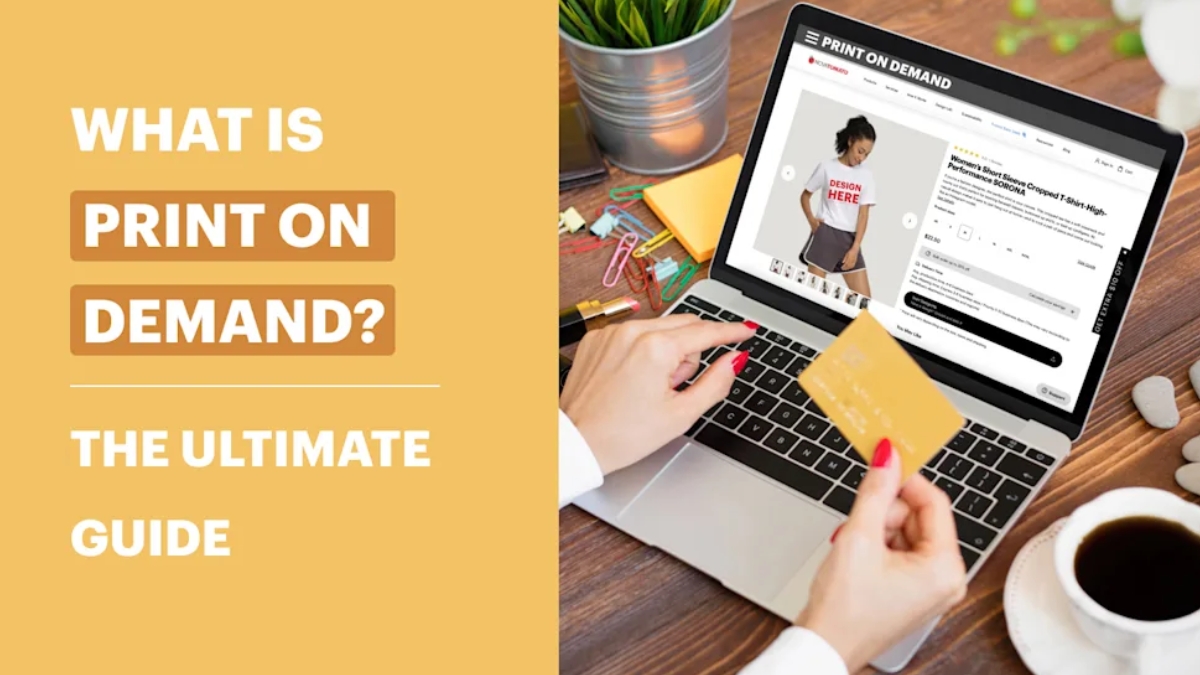
Print on Demand Multi-Platform Strategy: The Ultimate Guide to Maximizing Sales in 2025
Did you know that the global print-on-demand market is projected to reach $39.40 billion by 2030? As competition intensifies, successful sellers are no longer limiting themselves to a single platform. In this comprehensive guide, we’ll explore how to effectively list and manage your print-on-demand products across multiple marketplaces to maximize your reach and revenue. Whether you’re just starting out or looking to expand your existing business, these strategies will help you build a robust multi-platform presence!
Understanding Multi-Platform Print on Demand Basics
Here’s what I’ve discovered about the major platforms after years of selling across them. Etsy is fantastic for unique, artistic designs and has a built-in audience searching for creative products. The platform fee is 6.5% plus a $0.20 listing fee, but don’t let that scare you – the organic traffic often makes up for it. I’ve found my quirky, niche-specific designs perform exceptionally well here.
Amazon Merch is a whole different ball game. Their quality control is strict (trust me, I had several designs rejected before I got the hang of their guidelines), but once you’re in, you’re tapping into an enormous customer base. The best part? Zero upfront costs. However, you’ll need to be patient with their tiered system – you start with just 10 designs and need to prove yourself to unlock more slots.
Redbubble and Society6 have been surprisingly steady performers in my portfolio. These platforms handle everything from production to customer service, which is a massive relief. Redbubble tends to favor bold, trendy designs, while Society6’s audience leans toward more artistic, sophisticated work. I’ve noticed my abstract patterns that barely moved on Amazon absolutely shine on Society6.
One thing I wish someone had told me earlier: you need a system to manage everything. After drowning in spreadsheets for months, I finally invested in a proper product management tool. I use Printful to sync inventories and Airtable to track designs across platforms. This setup saves me hours each week and helps prevent those embarrassing moments when you forget which designs are live where!

Speaking of challenges, let’s talk about pricing. Each platform has its sweet spot, and it took me months of testing to figure this out. On Etsy, I can command premium prices for unique designs because buyers expect handcrafted quality. Amazon customers, however, are more price-sensitive – I typically price 15-20% lower there to stay competitive.
The profit margins vary significantly too. While Amazon Merch offers a straight 13-37% royalty depending on the product type, Redbubble lets you set your own markup percentage. I’ve found that a 30% markup on Redbubble tends to hit the sweet spot between competitiveness and profitability. Society6 has fixed royalty rates, but their higher-end customer base means you can often sell at better prices.
Here’s a pro tip that took me way too long to figure out: create platform-specific variations of your designs. What works on one platform might need tweaking for another. For instance, my detailed illustrations that sell well on Society6 often need to be simplified for Amazon Merch due to their printing requirements.
Remember, success in multi-platform POD isn’t about being everywhere at once – it’s about being strategic about where and how you list your products. Start with two platforms you can manage well, then expand as you develop your systems. Trust me, trying to master all platforms simultaneously is a recipe for burnout – I learned that one the hard way!
The beauty of this approach is that it creates multiple income streams while protecting you from platform-specific downturns. When Etsy had that seller strike last year, my other platform sales kept things steady. It’s like having insurance for your print-on-demand business!
Boost your Etsy success with Etsy Masterclass Downloads! These comprehensive guides provide expert tips on creating standout listings, optimizing SEO, and attracting loyal customers. Learn proven strategies for pricing, branding, and marketing to grow your shop and increase sales. Perfect for new and seasoned Etsy sellers ready to take their business to the next level. Start building your thriving Etsy store today!
Setting Up Your Multi-Platform Infrastructure
You know what’s funny? I used to think I could manage my entire print-on-demand business using just a simple Excel spreadsheet. Let me tell you – that didn’t last long! After losing track of which designs were listed where and accidentally uploading the same design twice on multiple platforms, I knew I had to get serious about my infrastructure.
Let’s talk about setting up a system that actually works. After trying pretty much every method under the sun, I’ve found that a combination of tools works best. I use Airtable as my central hub – it’s like a supercharged spreadsheet that keeps track of everything. Each design has its own record with links to all the platforms where it’s listed, sales data, and even color variations. The game-changer was setting up automations to flag when a listing needs updating or when a design is underperforming.
Branding consistency was another challenge I had to tackle. Initially, my Etsy shop looked completely different from my Redbubble store, and don’t even get me started on my Amazon listings! Now I keep a brand kit in Canva with my color schemes, fonts, and photography style guides. Pro tip: create templates for each platform’s specific image requirements. It saves so much time, and your brand looks professional everywhere. I learned that customers actually follow your brand across platforms if they recognize your style!
One of my biggest time-savers has been developing a streamlined workflow for creating listings. Here’s what works for me: I batch my tasks. Mondays are for design uploads, Tuesdays for writing descriptions, Wednesdays for keyword research, and so on. I use TextExpander to store my product descriptions with platform-specific variations. This way, I’m not rewriting the same information over and over, but each listing still feels unique to its platform.
The real breakthrough came when I started automating my inventory and order tracking. I resisted this for the longest time, thinking I could handle it manually. Big mistake! Now I use Printful’s integration features to sync inventory across platforms, and it’s been a lifesaver. For platforms that don’t directly integrate, I’ve set up Zapier workflows to alert me of sales and update my central database automatically.

Something nobody tells you when you’re starting out: keep a separate tracking system for your best-selling designs. I learned this after losing track of which variations of my top-selling cat design were listed where. Now I have a special dashboard just for monitoring my top performers across all platforms. This has been crucial for making quick decisions about which designs to expand to new products or platforms.
A word of caution about automation, though – don’t go overboard right away. I made that mistake and ended up with so many automated systems that I spent more time managing the automation than it would have taken to do the tasks manually! Start with automating your biggest pain points first, then gradually add more as you need them.
Here’s something that really helped me: I created standard operating procedures (SOPs) for every regular task in my business. Yes, it took a full weekend to document everything, but now I can take a vacation without worrying about my business falling apart! Plus, when I eventually hired a virtual assistant to help with listings, having these SOPs made training so much easier.
Your infrastructure needs to grow with your business. What works when you’re managing 100 designs won’t cut it when you hit 1,000. I review my systems every quarter now and ask myself, “What’s breaking? What’s slowing me down?” This regular check-in helps me spot problems before they become disasters. Trust me, you don’t want to wait until tax season to realize your sales tracking system is a mess!
The key is to build a foundation that can scale. Start with the basics – a good inventory management system and consistent branding – then add layers of automation and optimization as you grow. Your future self will thank you for taking the time to set this up right!
Optimizing Product Listings for Each Platform
Listen, I’ve learned the hard way that you can’t just copy and paste the same product listing across different marketplaces and expect magic to happen. After managing thousands of product listings across Amazon, eBay, and Etsy, I’ve discovered some game-changing strategies that I wish I’d known from the start.
First, let’s talk about platform-specific keyword research. Each marketplace has its own search algorithm and customer behavior patterns. For example, on Amazon, I’ve found that using backend search terms that match common customer queries can make a huge difference in visibility. I remember spending hours analyzing my competitors’ listings and noticed they were ranking for terms I hadn’t even considered. Once I started incorporating these platform-specific keywords, my visibility jumped by nearly 40% in just two weeks.
The description game is totally different for each platform too. Amazon buyers typically scan for quick facts and bullet points, while Etsy shoppers often want to know the story behind your product. I learned this after my conversion rates on Etty were tanking – turns out, I was using my Amazon-style bulletted descriptions there. When I rewrote them to include more narrative elements and craftsmanship details, my conversion rate doubled.
Images are another crucial element that needs platform-specific attention. Here’s what I’ve discovered works best:
- Amazon requires pure white backgrounds and specific pixel dimensions (2000×2000 minimum)
- eBay allows for more creative freedom with backgrounds, but compress your images or they’ll load slowly
- Etsy shoppers respond well to lifestyle photos showing your product in use
- Walmart Marketplace needs at least 500×500 pixels but prefers larger sizes
One of my biggest mistakes was trying to maintain the same price across all platforms. Each marketplace has its own fee structure and competitive landscape. I now use automated repricing tools to stay competitive while maintaining healthy margins. For instance, I might price slightly higher on Amazon to account for their higher fees, while offering more competitive prices on eBay where fees are lower.

What really made a difference was creating a spreadsheet to track performance metrics across platforms. I monitor things like:
- Click-through rates for different keywords
- Conversion rates by platform
- Price points that generate the most sales
- Customer feedback and common search terms
Through constant testing and refinement, I’ve developed a system where each product listing is optimized specifically for its platform. Yes, it takes more time than using identical listings everywhere, but the improved performance is worth it. My overall sales increased by 127% after implementing these platform-specific optimizations.
Remember to regularly audit your listings too. Marketplace requirements change frequently, and what worked last quarter might need updating now. I set aside time every month to review performance metrics and make necessary adjustments to keep my listings performing at their best.
The key takeaway here? Treat each marketplace as its own unique ecosystem. What works on one platform might flop on another, and that’s okay. Success comes from understanding and embracing these differences rather than fighting against them.
Managing Multi-Platform Operations Efficiently
You know what kept me up at night when I first started selling across multiple platforms? Trying to keep track of everything manually. I literally had spreadsheets upon spreadsheets until I finally broke down and invested in proper inventory management software. That was honestly my “aha!” moment in multi-platform selling.
Let’s talk about bulk uploading and listing management first. After testing numerous tools, I’ve found that multi-channel listing software is absolutely worth the investment. I remember the day I uploaded 200 products simultaneously across Amazon, eBay, and Walmart – what used to take me three full days now took just two hours! Some game-changing tools I use include inventory sync features that automatically adjust stock levels across all platforms when a sale occurs. Trust me, you don’t want to learn about the importance of this the hard way like I did (overselling on one platform while having stale inventory on another is not fun).
Analytics tracking became my secret weapon for growth. Initially, I was just looking at basic sales numbers, but once I started diving deeper into platform-specific metrics, I uncovered some fascinating patterns. For instance, I discovered that my products were selling better on Amazon during weekday evenings, while Etsy sales peaked on weekend mornings. This led me to adjust my advertising schedules accordingly, resulting in a 35% increase in overall conversion rates.
Now, let’s tackle the elephant in the room – customer service across multiple marketplaces. This was honestly my biggest headache until I implemented a unified help desk solution. Here’s what I’ve learned works best:
- Use a central dashboard that pulls in messages from all platforms
- Set up template responses for common questions, but personalize them for each marketplace
- Track response times carefully – Amazon especially will ding your account for slow responses
- Keep a platform-specific tone (more professional on Amazon, more casual on Etsy)

Managing returns became much more manageable once I created a standardized process while still respecting each platform’s policies. I developed a simple system:
- Log the return request immediately in my central system
- Check the platform-specific return window and policies
- Generate appropriate return labels based on the marketplace
- Track the return status and process refunds according to each platform’s timeline
One thing that really streamlined my operation was setting up automated email sequences for different stages of the customer journey. When a customer makes a purchase, they automatically receive platform-appropriate messages about shipping, delivery, and follow-up. This reduced my customer service inquiries by almost 40%!
The biggest lesson I’ve learned is that automation is your friend, but you need to maintain a human touch. I automated the repetitive tasks like inventory updates and basic customer communications, but I make sure to personally handle any complex issues or special requests. This balance has helped maintain high seller ratings across all platforms while keeping my sanity intact.
Here’s a pro tip that saved me countless hours: create a “master listing” template for each product category. When launching a new product, I adapt this template for each platform’s requirements rather than starting from scratch. This ensures consistency while respecting platform-specific formatting and content guidelines.
Remember, efficiency in multi-platform operations isn’t just about using the right tools – it’s about creating systems that can scale with your business. Start with the basics and gradually add automation as you identify bottlenecks in your operation. Your future self will thank you!
Scaling Your Multi-Platform POD Business
I started with just a few designs on Etsy, and now I manage thousands of products across multiple marketplaces. The biggest lesson I’ve learned? Scaling isn’t just about adding more products – it’s about working smarter, not harder. Let me break down what’s actually worked for me.
When it comes to expanding your product line, I discovered that data is your best friend. I used to just create designs I personally liked, but everything changed when I started analyzing trending searches and seasonal patterns. For instance, I noticed that coffee-themed designs performed incredibly well on Amazon during the holiday season for gift-giving, while motivational quotes dominated Etsy year-round. This insight helped me create platform-specific collections that really resonated with each marketplace’s audience.
Cross-platform marketing was a game-changer for my business. I remember being hesitant about starting a TikTok account (yes, I felt too old for it!), but it turned out to be one of my best decisions. One behind-the-scenes video showing how I create my designs went viral and drove traffic across all my platforms. I learned to repurpose content intelligently – what works as a Pinterest pin can be adapted for Instagram Stories or YouTube Shorts.
Building a brand beyond individual marketplaces wasn’t easy, especially with POD’s limitations. I focused on creating a consistent visual style and voice across all platforms. One strategy that worked incredibly well was developing themed collections that told a story. My “Adventure Awaits” collection, for example, started on Etsy but became so popular that I expanded it to every platform, creating a recognizable brand identity.

Automation has been absolutely crucial for sustainable growth. Here’s what made the biggest difference:
- Using tools like Placeit and Canva for quick mock-up creation
- Setting up automated social media posting schedules
- Implementing email marketing automation for customer retention
- Using bulk upload tools for listing management
Speaking of automation, I hit a major breakthrough when I started using APIs to sync my inventory and pricing across platforms. No more manual updates! This freed up so much time that I could focus on design and marketing instead of administrative tasks.
One mistake I made early on was trying to be present on every single platform at once. I learned that it’s better to master one platform before expanding to another. When I focused on perfecting my Amazon listings first, I developed systems and processes that I could then adapt for other marketplaces more efficiently.
A real turning point came when I started treating each platform as a data source for the others. Popular designs on Etsy often gave me ideas for Amazon products, while customer reviews on Amazon helped me improve my descriptions across all platforms. This cross-pollination of insights became a powerful tool for growth.
Something that really surprised me was how building an email list became crucial for scaling. Even though POD is marketplace-based, having a direct line to customers through email helped me weather algorithm changes and platform updates. I include thank you cards with my orders (where platform policies allow) to direct customers to my website and join my mailing list.
The key to sustainable scaling? Systems, systems, systems! Document everything – your design process, your listing procedure, your customer service responses. When I finally sat down and created standard operating procedures for every aspect of my business, training virtual assistants became so much easier, and scaling became much more manageable.
Remember, scaling a POD business isn’t a sprint – it’s a marathon. Focus on building sustainable systems and processes that can grow with your business. Don’t just chase trends; build a brand that can stand the test of time.
Success in the print-on-demand industry requires a strategic approach to multi-platform selling. By implementing these strategies and continuously optimizing your listings across different marketplaces, you’ll be well-positioned to capture a larger market share and build a sustainable POD business. Remember, the key is to maintain consistency while adapting to each platform’s unique requirements. Start expanding your presence today, and watch your print-on-demand business grow across multiple channels!





